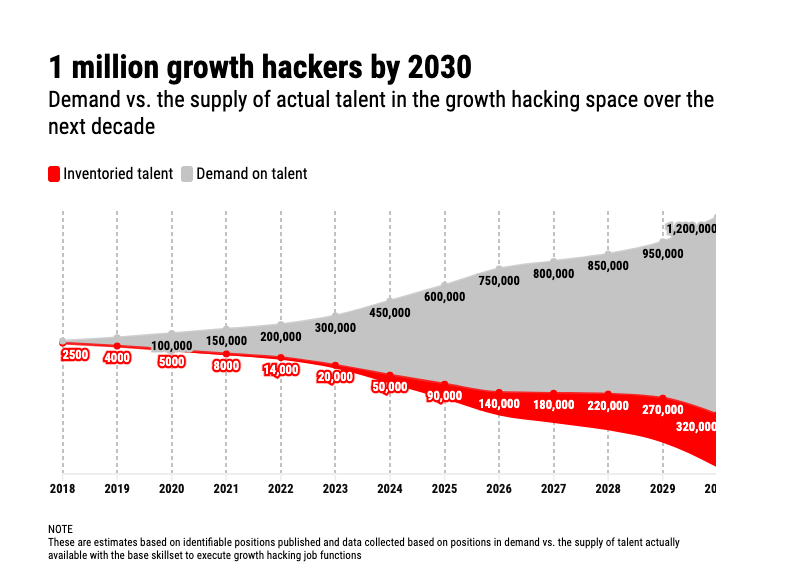The Growing Gap for Growth Hackers
The rise of digital transformation has increased the demand for professionals with growth hacking skills. However, the talent supply has not kept pace with demand, resulting in a growing gap between the two. This article will explore the problem, its future implications, and what companies can do to address it.

What the big problem here is:
The problem is the growing gap between supply and demand for growth hacking talent. While demand for these skills has steadily increased, the talent supply has not kept pace. In 2018, the supply of growth hacking talent was only 2,500, while demand was 12,000, resulting in a 9,500 or 21% talent gap. Over the next 12 years, while the supply of talent is projected to increase to 320,000 in 2030, the gap between supply and demand is expected to remain significant, hovering around 80-145% throughout the period.
Evidence:
- In 2019, the gap between supply and demand was 46,000, or 409%.
- In 2024, the gap is projected to reach 400,000, or 139%.
- In 2030, the gap is projected to be 880,000 or 100%.
What this problem is going to look like in the future:
As the demand for growth hacking talent continues to rise, the gap between supply and demand is expected to widen. The talent shortage will lead to fierce competition among companies, particularly those in the technology industry, to attract and retain individuals with the necessary skills. This will increase salaries and benefits for growth hacking professionals, making it more difficult for small businesses and startups to compete.
Evidence:
- In 2025, the demand for growth hacking talent is expected to reach 600,000 while the supply will be 510,000, resulting in a gap of 90,000 or 15%.
- In 2028, the gap is projected to be 630,000 or 26%, making it increasingly difficult for companies to find the right talent.
What will happen as an implication of this problem:
The shortage of growth hacking talent will have significant implications for businesses. Companies will struggle to innovate and grow, as they will not have the necessary skills to drive growth through digital channels. This will result in increased competition, and those without the skills will be left behind. Furthermore, the inability to find and retain growth hacking talent will hinder companies from reaching their growth targets and may lead to stunted growth.
Evidence:
- As of 2020, the talent supply was only 5,000 while the demand was 100,000, resulting in a gap of 95,000 or 195%.
- In 2023, the demand for growth hacking talent is projected to reach 300,000 while the supply will be 280,000, resulting in a gap of 20,000 or 7%.
Subscribe for updates
The growing gap between supply and demand for growth hacking talent
The growing gap between supply and demand for growth hacking talent is a significant problem that businesses must address. To close the gap, companies may need to invest in training and development programs to build internal that are the future implications of the growing gap between supply and demand for growth hacking talent? talent or tap into non-traditional talent pools to find individuals with the necessary skills. Companies will struggle to innovate and grow without addressing the issue and may risk being left behind in an increasingly competitive market.
01. “Growth Hacking Talent Gap: A Looming Crisis”
- Analysis: From 2018 to 2030, the gap between the supply and demand for growth hacking talent is increasing alarmingly.
- Prediction: The demand for growth hacking talent will continue to outpace the supply, resulting in a larger talent gap.
- Implications: Companies that fail to address this talent gap will struggle to compete in a digital economy, leading to potential revenue and market share losses.
02. “Rising Demand for Growth Hacking Talent: Is Your Business Prepared?”
- Analysis: The demand for growth hacking talent is increasing exponentially, with a predicted 1,200,000 jobs by 2030.
- Prediction: The demand for growth hacking talent will continue to rise, particularly as businesses embrace digital transformation.
- Implications: Companies that cannot attract and retain growth hacking talent will struggle to innovate and remain competitive in their respective markets.
03. “The Supply-Side Dilemma: Challenges of Bridging the Growth Hacking Talent Gap.”
- Analysis: Despite an increase in the supply of growth hacking talent from 2,500 in 2018 to 320,000 in 2030, the gap between supply and demand remains significant.
- Prediction: Companies must invest in training and development programs to bridge the talent gap and ensure their workforce is equipped with the necessary skills.
- Implications: Failure to invest in training and development could lead to a talent shortage, leaving businesses unable to meet their growth targets.
04. “The Cost of Ignoring the Growth Hacking Talent Gap.”
- Analysis: Companies that fail to address the growth hacking talent gap risk losing revenue and market share to competitors who have invested in attracting and retaining top talent.
- Prediction: The growth hacking talent gap will continue to widen, making it increasingly difficult for companies to find and hire the right candidates.
- Implications: Businesses must prioritize addressing the talent gap through training and development initiatives, partnering with universities and trade schools, and offering competitive compensation and benefits packages.
05. “Building a Pipeline for Growth Hacking Talent: A Strategic Imperative.”
- Analysis: To bridge the growth hacking talent gap, businesses must take a proactive approach to recruitment and talent development.
- Prediction: Companies that invest in building a talent pipeline through internships, mentorship programs, and partnerships with educational institutions will be better positioned to compete in a digital economy.
- Implications: Prioritizing talent development and recruitment will enable companies to remain agile and responsive to changing market conditions while ensuring their workforce has the necessary skills to drive growth and innovation.
Subscribe for updates
What hiring managers need to consider
Hiring managers have a massive challenge in front of them, and taking this one today is vital to help deal with the growing gap. Although this may not be easy, starting now helps hiring managers figure out how to win the war on talent for growth hackers,
The Talent Gap
- Despite an increase in the supply of growth hacking talent, the gap between supply and demand remains significant.
- Companies must take a proactive approach to recruitment and talent development to bridge the gap.
Competition for Talent
- Competition for top candidates will increase as demand for growth hacking talent continues to rise.
- Companies must offer competitive compensation and benefits packages to attract and retain top talent.
Skill Set
- Growth hacking requires unique skills, including data analysis, marketing, and coding.
- Companies must ensure their workforce has the necessary skills to drive growth and innovation.
Training and Development
- Companies must invest in training and development programs to bridge the talent gap and ensure their workforce has the necessary skills.
- Partnerships with universities and trade schools can help companies attract and develop talent.
Future Trends
- The demand for growth hacking talent will continue to rise, particularly as businesses embrace digital transformation.
- Companies must anticipate future trends and adapt their recruitment and talent development strategies accordingly.
Importance of Growth Hacking Talent
- Failure to address the growth hacking talent gap could lead to potential revenue and market share losses.
- Companies must prioritize attracting and retaining top growth hacking talent to remain competitive in a digital economy.
The Growing Gap for Growth Hackers is real.
By considering these factors and taking proactive steps to address the growth hacking talent gap, companies can ensure they have the necessary talent to drive growth and innovation.
As a prediction, the demand for growth hacking talent will only increase as businesses continue to prioritize digital transformation and innovation.
Companies must anticipate future trends and invest in the necessary training and development to bridge the talent gap and remain competitive in a digital economy.
Failure to address the growth hacking talent gap could lead to potential revenue and market share losses. By prioritizing growth hacking talent and taking proactive steps to address the talent gap, companies can position themselves for long-term success and growth.
Subscribe for updates
Learn how to grow hack using the growth thinking methodology.
To learn more, go to https://www.mygrowththinking.com
or get the book on Amazon





